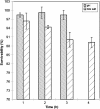Isolation of Pediococcus acidilactici Kp10 with ability to secrete bacteriocin-like inhibitory substance from milk products for applications in food industry
- PMID: 23153191
- PMCID: PMC3571982
- DOI: 10.1186/1471-2180-12-260
Isolation of Pediococcus acidilactici Kp10 with ability to secrete bacteriocin-like inhibitory substance from milk products for applications in food industry
Abstract
Background: Lactic acid bacteria (LAB) can be isolated from traditional milk products. LAB that secrete substances that inhibit pathogenic bacteria and are resistant to acid, bile, and pepsin but not vancomycin may have potential in food applications.
Results: LAB isolated from a range of traditional fermented products were screened for the production of bacteriocin-like inhibitory substances. A total of 222 LAB strains were isolated from fermented milk products in the form of fresh curds, dried curds, and ghara (a traditional flavor enhancer prepared from whey), and fermented cocoa bean. Eleven LAB isolates that produced antimicrobial substances were identified as Lactococcus lactis, Lactobacillus plantarum, and Pediococcus acidilactici strains by biochemical methods and 16S rDNA gene sequencing. Of these, the cell-free supernatant of Kp10 (P. acidilactici) most strongly inhibited Listeria monocytogenes. Further analysis identified the antimicrobial substance produced by Kp10 as proteinaceous in nature and active over a wide pH range. Kp10 (P. acidilactici) was found to be catalase-negative, able to produce β-galactosidase, resistant to bile salts (0.3%) and acidic conditions (pH 3), and susceptible to most antibiotics.
Conclusion: Traditionally prepared fermented milk products are good sources of LAB with characteristics suitable for industrial applications. The isolate Kp10 (P. acidilactici) shows potential for the production of probiotic and functional foods.
Figures



References
-
- Pal V, Jamuna M, Jeevaratnam K. Isolation and characterization of bacteriocin producing lactic acid bacteria from a South Indian Special dosa (Appam) batter. J Culture Collect. 2005. pp. 53–60.
MeSH terms
Substances
Associated data
- Actions
LinkOut - more resources
Full Text Sources
Other Literature Sources
Molecular Biology Databases
Miscellaneous

